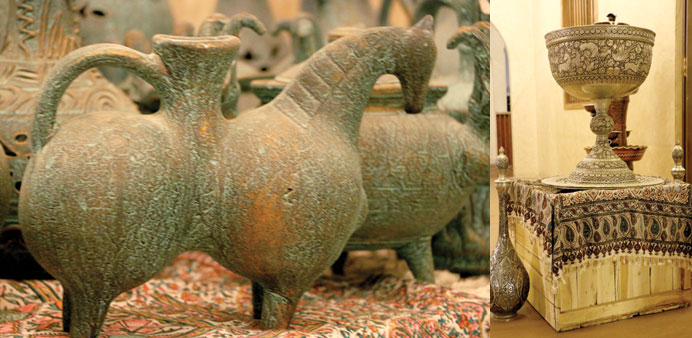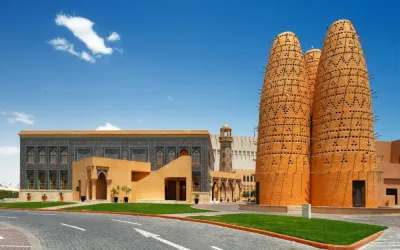CREATIVITY: Animal forms are blended into the design idea. Right: UTILITY: Such items were used as utensils for storing food in ancient Iran. Photos by Umer Nangiana
By Umer Nangiana
Persian potters and ceramic artists have been known for their skills through centuries throughout the world. The history of the art of pottery in Iran goes back to ancient times. Some say it started there with the advent of agriculture when people started cultivation. They baked clay to produce utensils to meet their needs.
Though not produced with the same ancient artistic excellence, the Iranian ceramics and pottery still manage to attract large audience world over. While the ancient ones produced by masters are preserved in museums and other public and private collections, the more contemporary pieces of ceramics and decorative pottery are equally popular.
One of the best selections of Iranian contemporary ceramics, some produced through centuries-old traditional methods, have been selling well at Katara market in Katara Cultural Complex this Ramadan. The pieces of Iranian pottery, also known as gombroon, styled on the ancient designs and colour schemes, have been attracting the attention of visitors.
“We have all kinds of ceramics. There are vases in different styles and colours and we also have jars and bowls besides spouted jugs and water and tea sets. They all come from different areas in Iran but most of them are from Isfahan,” a salesperson at the store, without giving his name, told Community.
The Iranian ceramics production presents a continuous history from the beginning of Iranian history until the present day. The modern ones still carry the fingerprints of the simpler primitive Persian earthenware. In fact, more are deliberately designed on the same pattern to keep their connection with history alive.
The collection at Katara market comprises utensils that are primitive in nature displaying the original black and red colour tones besides the ones decorated with geometric designs, drawings and miniature artwork.
“Most of them are mass produced these days while there still are some traditional production units in Iran that manufacture them in the original ancient style,” said the salesman.
Studying the designs on these items of ceramics shows the Iranian artists’ skills in designing earthenware and representing their works in a lively and gracious manner. Iran is known as the birthplace of designed earthenware utensils. Designing earthenware in Iran started about 4000 BC. And the inherited expertise shows in the finished product.
In ancient Iran, the earthenware was baked more carefully in newly-made kilns. Shapes and forms of these potteries indicate invention of the pottery rotating instrument may be of that time. In the old times, the artisans produced a variety of utensils like piped pots, bowls and jars to store corn and grain.
Forms of animals and birds have been blended into the design of the pots to enhance their ornamental value. Due to the special geographical position of Iran, being at the crossroads of ancient civilisations and on important caravan routes, almost every part of Iran was, at times, involved in pottery making.
However, there were four major pottery-manufacturing areas in the Iranian plateau. Isfahan, the cultural hub of the country and one of the oldest cities, still produces its signature blue and white ware and an underglaze polychrome-painted ware which it has been known for throughout the 19th century.
There are duplicate replicas of the designs from Safavid (dynasty) pottery. It was a new type of pottery painted in blue and black with pierced decoration with a clear glaze filling the small windows, made in Nayin during the 19th century.
Through the centuries, Persian potters have responded to the demands and changes brought by political turmoil by adopting and refining new forms and blending them into their own culture. This innovative attitude has survived through time and influenced many other cultures around the world.
There are big collections of Persian pottery at the British Museum, the Hermitage Museum, and the Royal Ontario Museum. This unique collection of pottery and ceramics is available in Katara market for the remaining days of Ramadan and Eid holidays.



